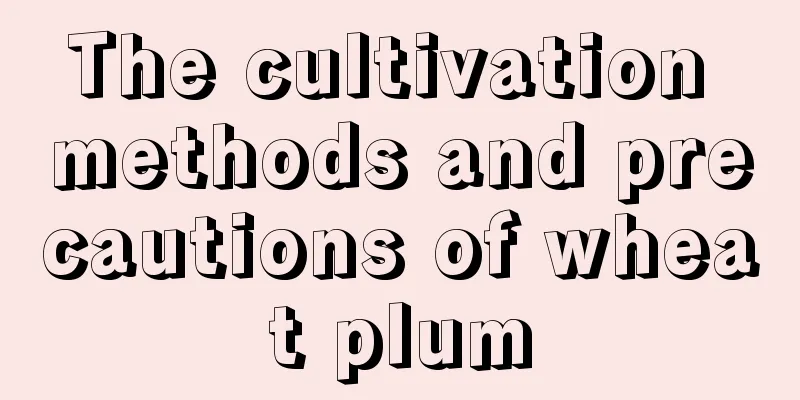The cultivation methods and precautions of wheat plum

1. Maintenance methods1. Temperature: When the temperature exceeds 35 degrees, the plant will enter a semi-dormant state. When the temperature is between 15 and 30 degrees, it can grow normally, but the temperature required for the best growth state is around 22 degrees. The wintering temperature must be kept above ten degrees, otherwise the plants will be frostbitten. 2. Watering: It likes moisture but cannot tolerate waterlogging, so pay attention to the amount of watering. Water it until the soil is completely moist but there should be no water accumulation in the soil. The temperature is relatively high in summer, so it is best to water the plants every day. In autumn and winter, the temperature is relatively low, so watering two to three times a week is sufficient. 3. Fertilization: It needs to be given nitrogen fertilizer once during growth in order to promote the growth of branches and leaves. Depending on its growth status, it can also be given phosphorus fertilizer once before flowering in order to promote bud growth. 4. Light: If there is insufficient light, the plant will grow too tall. Generally, six hours of light a day is sufficient. Because it is not resistant to strong light, it needs to be shaded in midsummer, but can be exposed to normal light in other seasons. 2. Breeding techniques1. Reproduction: It can be propagated by cuttings. June and July each year are the best time for branch growth, so it is best to choose this time for cuttings. First, choose two-year-old semi-lignified branches and cut them into cuttings about ten centimeters long. Keep one-third of the leaves on the upper end to reduce water evaporation and nutrient absorption. Leave two-thirds because its growth requires photosynthesis. All the leaves on the lower end need to be cut off, cut into a 45-degree section at the bottom, and then insert them into the prepared culture medium. Roots will grow in about half a month. 2. Pruning: Its branches are very thin and dense, and very flexible. You can make your favorite shape based on this feature. It has a strong vitality. If the branches are too dense, you can prune them appropriately. After pruning, be careful not to let the incision come into contact with water. Wait until the incision is dry before watering normally. 3. Problem Diagnosis1. Pests: The plant is easily infected by tent caterpillars, which mainly absorb the branches and leaves of the plant and affect the growth of the plant. Once discovered, it is necessary to use omethoate to spray and treat. 2. Disease: The drooping of branches and leaves of the plant is mostly caused by excessive light. The lighting method needs to be changed to mainly diffuse light. IV. Other issues1. Edibility: It is not edible. 2. Toxicity: non-toxic. |
<<: Cultivation methods and precautions of Ma Yinhua
>>: Cultivation methods and precautions of flat peaches
Recommend
Are chrysanthemums suitable for deep or shallow pots?
Should chrysanthemums be placed in deep or shallo...
How to judge whether the rose needs watering?
Roses are very hardy and can tolerate cold and dr...
How to grow hibiscus on the balcony, what should be paid attention to
1. Light supplement Hibiscus can tolerate partial...
When is the best time to plant autumn coriander?
Coriander , also known as cilantro, is a vegetabl...
How to judge whether orchids are lacking water and fertilizer, and how to replenish water and fertilizer
1. How to judge 1. Lack of water: If the orchid i...
Why do gardenia buds fall off before opening?
Every June and July, gardenias usually enter a se...
How many acres of land can be planted with 4400 corn seeds (how many corn plants can be planted in one acre of land)
Now is the planting season of summer corn here, t...
Can the money tree be watered with rice water?
1. Is it possible? Rice water is kitchen waste wa...
50 common foliage plants illustrations, the most comprehensive in history
ivy Pothos Chlorophytum Wedding Chlorophytum Prun...
Can the newly transplanted osmanthus tree be pruned (how to prune the newly planted osmanthus tree potted plant)
In fact, the purpose of pruning potted osmanthus ...
How and when to plant vegetables Steps to plant vegetables
When planting vegetables, the seeds need to be so...
How many times can spinach be planted in a year?
When it comes to spinach , many people mistakenly...
What is Perilla and what are its functions?
1. What is 1. Family: Perilla is a plant of the L...
Don’t throw away the leftover pomegranate peels, put them in the refrigerator and all the odors will disappear. It’s so practical!
Don’t be fooled by the plump pomegranates. They w...
How often should you water the lucky tree at home?
The lucky tree is a very popular indoor foliage p...









